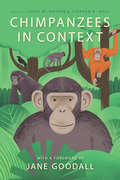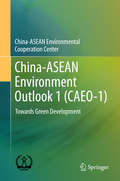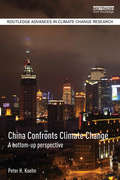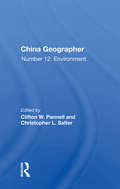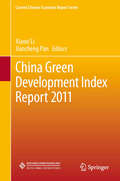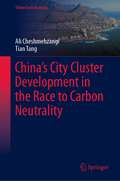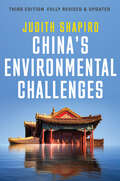- Table View
- List View
Chimpanzees in Context: A Comparative Perspective on Chimpanzee Behavior, Cognition, Conservation, and Welfare
by Lydia M. Hopper Stephen R. RossThe study of the chimpanzee, one of the human species’ closest relatives, has led scientists to exciting discoveries about evolution, behavior, and cognition over the past half century. In this book, rising and veteran scholars take a fascinating comparative approach to the culture, behavior, and cognition of both wild and captive chimpanzees. By seeking new perspectives in how the chimpanzee compares to other species, the scientists featured offer a richer understanding of the ways in which chimpanzees’ unique experiences shape their behavior. They also demonstrate how different methodologies provide different insights, how various cultural experiences influence our perspectives of chimpanzees, and how different ecologies in which chimpanzees live affect how they express themselves. After a foreword by Jane Goodall, the book features sections that examine chimpanzee life histories and developmental milestones, behavior, methods of study, animal communication, cooperation, communication, and tool use. The book ends with chapters that consider how we can apply contemporary knowledge of chimpanzees to enhance their care and conservation. Collectively, these chapters remind us of the importance of considering the social, ecological, and cognitive context of chimpanzee behavior, and how these contexts shape our comprehension of chimpanzees. Only by leveraging these powerful perspectives do we stand a chance at improving how we understand, care for, and protect this species.
Chimpanzees in Context: A Comparative Perspective on Chimpanzee Behavior, Cognition, Conservation, and Welfare
The study of the chimpanzee, one of the human species’ closest relatives, has led scientists to exciting discoveries about evolution, behavior, and cognition over the past half century. In this book, rising and veteran scholars take a fascinating comparative approach to the culture, behavior, and cognition of both wild and captive chimpanzees. By seeking new perspectives in how the chimpanzee compares to other species, the scientists featured offer a richer understanding of the ways in which chimpanzees’ unique experiences shape their behavior. They also demonstrate how different methodologies provide different insights, how various cultural experiences influence our perspectives of chimpanzees, and how different ecologies in which chimpanzees live affect how they express themselves. After a foreword by Jane Goodall, the book features sections that examine chimpanzee life histories and developmental milestones, behavior, methods of study, animal communication, cooperation, communication, and tool use. The book ends with chapters that consider how we can apply contemporary knowledge of chimpanzees to enhance their care and conservation. Collectively, these chapters remind us of the importance of considering the social, ecological, and cognitive context of chimpanzee behavior, and how these contexts shape our comprehension of chimpanzees. Only by leveraging these powerful perspectives do we stand a chance at improving how we understand, care for, and protect this species.
CHINA & THE GEOPOLITICS OF RARE EARTHS C
by Sophia KalantzakosFeaturing a new foreword that brings the book up to date Rare earths are elements that are found in the Earth's crust, and are vital ingredients for the production of a wide variety of high tech, defense, and green technologies-everything from iPhones and medical technologies to wind turbines, efficiency lighting, smart bombs, and submarines. While they are not particularly "rare" in availability, they are difficult and expensive to mine. Yet, China has managed to gain control over an estimated 97 percent of the rare earth industry since the 1990s through cheap production, high export taxes, and artificial limitations of supply. Rare earths, and China's monopoly over them, became international news after China "unofficially" curtailed exports to Japan, the United States, and Europe in 2010. This embargo followed a collision between Chinese and Japanese boats in the East China Sea, a locus of geopolitical and economic tension between the two countries. Although the World Trade Organization forced China to scrap its restrictions, it still holds a stranglehold over these elements that are so critical to the economic and security interests of the United States and its allies. In this book, Sophia Kalantzakos argues that the 2010 rare earth crisis signaled more than just a trade dispute. Rather, it raises questions about China's use of economic statecraft, and must be regarded as a part of the larger discourse of global power relations. Importantly, she also argues that the failure of political actors in major industrial nations to enact comprehensive and effective policy solutions, or the scientific and business communities to devise sustainable rare earth production outside of China, points to future resource competition. Featuring a new foreword, the paperback edition of China and the Geopolitics of Rare Earths examines the impacts of growing worldwide resource competition and the complexities policymakers face as they develop strategies and responses in an increasingly globalized world.
China and Great Power Responsibility for Climate Change (Rethinking Asia and International Relations)
by Sanna KopraAs American leadership over climate change declines, China has begun to identify itself as a great power by formulating ambitious climate policies. Based on the premise that great powers have unique responsibilities, this book explores how China’s rise to great power status transforms notions of great power responsibility in general and international climate politics in particular. The author looks empirically at the Chinese party-state’s conceptions of state responsibility, discusses the influence of those notions on China’s role in international climate politics, and considers both how China will act out its climate responsibility in the future and the broader implications of these actions. Alongside the argument that the international norm of climate responsibility is an emerging attribute of great power responsibility, Kopra develops a normative framework of great power responsibility to shed new light on the transformations China’s rise will yield and the kind of great power China will prove to be. The book will be of interest to students and scholars of international relations, China studies, foreign policy studies, international organizations, international ethics and environmental politics.
China and Great Power Responsibility for Climate Change (Rethinking Asia and International Relations)
by Sanna KopraAs American leadership over climate change declines, China has begun to identify itself as a great power by formulating ambitious climate policies. Based on the premise that great powers have unique responsibilities, this book explores how China’s rise to great power status transforms notions of great power responsibility in general and international climate politics in particular. The author looks empirically at the Chinese party-state’s conceptions of state responsibility, discusses the influence of those notions on China’s role in international climate politics, and considers both how China will act out its climate responsibility in the future and the broader implications of these actions. Alongside the argument that the international norm of climate responsibility is an emerging attribute of great power responsibility, Kopra develops a normative framework of great power responsibility to shed new light on the transformations China’s rise will yield and the kind of great power China will prove to be. The book will be of interest to students and scholars of international relations, China studies, foreign policy studies, international organizations, international ethics and environmental politics.
China and the Environment: The Green Revolution (Asian Arguments)
by Sam GeallSixteen of the world's 20 most polluted cities are in China. A serious water pollution incident occurs once every two-to-three days. China's breakneck growth causes great concern about its global environmental impacts, as others look to China as a source for possible future solutions to climate change. But how are Chinese people really coming to grips with environmental problems? This book provides access to otherwise unknown stories of environmental activism and forms the first real-life account of China and its environmental tensions.'China and the Environment' provides a unique report on the experiences of participatory politics that have emerged in response to environmental problems, rather than focusing only on macro-level ecological issues and their elite responses. Featuring previously untranslated short interviews, extracts from reports and other translated primary documents, the authors argue that going green in China isn't just about carbon targets and energy policy; China's grassroots green defenders are helping to change the country for the better.
China and the Geopolitics of Rare Earths
by Sophia KalantzakosFeaturing a new foreword that brings the book up to date Rare earths are elements that are found in the Earth's crust, and are vital ingredients for the production of a wide variety of high tech, defense, and green technologies-everything from iPhones and medical technologies to wind turbines, efficiency lighting, smart bombs, and submarines. While they are not particularly "rare" in availability, they are difficult and expensive to mine. Yet, China has managed to gain control over an estimated 97 percent of the rare earth industry since the 1990s through cheap production, high export taxes, and artificial limitations of supply. Rare earths, and China's monopoly over them, became international news after China "unofficially" curtailed exports to Japan, the United States, and Europe in 2010. This embargo followed a collision between Chinese and Japanese boats in the East China Sea, a locus of geopolitical and economic tension between the two countries. Although the World Trade Organization forced China to scrap its restrictions, it still holds a stranglehold over these elements that are so critical to the economic and security interests of the United States and its allies. In this book, Sophia Kalantzakos argues that the 2010 rare earth crisis signaled more than just a trade dispute. Rather, it raises questions about China's use of economic statecraft, and must be regarded as a part of the larger discourse of global power relations. Importantly, she also argues that the failure of political actors in major industrial nations to enact comprehensive and effective policy solutions, or the scientific and business communities to devise sustainable rare earth production outside of China, points to future resource competition. Featuring a new foreword, the paperback edition of China and the Geopolitics of Rare Earths examines the impacts of growing worldwide resource competition and the complexities policymakers face as they develop strategies and responses in an increasingly globalized world.
China-ASEAN Environment Outlook 1 (CAEO-1): Towards Green Development
by China-ASEAN Environmental CooperationThis book presents a comprehensive analysis of the status and progress of China-ASEAN green development and examines the common development issues in China and ASEAN Member States (AMSs). It also explores development trends within the framework of global and regional environmental governance and discusses the approaches towards green development in China and AMSs, offering its own definition of green development and using a “pressure-state-response” (PSR) model to build a framework for assessing green development. The book includes typical policy measures and numerous practices for green development in China and AMSs in the form of tables, figures and boxes. Based on detailed analysis, it argues that the global 2030 Agenda for Sustainable Development brings significant opportunities to China and AMSs, that the ongoing pragmatic cooperation should be further advanced, and that a connection between the Belt and Road Initiative and green ASEAN Community should be established to achieve regional sustainable development. As such it furthers readers’ understanding of environment and development and practical policy advice for promoting China-ASEAN cooperation on environment and green development. Intended for decision makers from the government, business sector, and civil societies who are working to boost green development and China-ASEAN cooperation, it is also a valuable resource for government officials, researchers and non-experts interested in creating a balanced relationship between the environment and development.
China Confronts Climate Change: A bottom-up perspective (Routledge Advances in Climate Change Research)
by Peter H. KoehnChina is an integral actor in any movement that will stabilize the global climate at conditions suited to sustainable development for its own population and for people living around the world. Assessments of China’s climatic-system consequences, impact, and responsibilities need to take into account the strengths, weaknesses, and potential of subnational governments, non-governmental organizations, transnational non-state connections, and the urban populace in reducing greenhouse-gas emissions. A multitude of recent local initiatives that have engaged subnational China in actions that mitigate emissions can be enhanced by powerful framings that appeal to citizen concerns about air pollution and health conditions. China Confronts Climate Change offers the first fully comprehensive account of China’s response to climate change, based on engagement with the global climate governance literature and current debates over responsibility along with specific insights into the Chinese context. Responsible implementation of any overarching climate agreement depends on expanding China’s subnational contributions. To remain fully informed about GHG-emissions mitigation, China watchers and climate-change monitors need to pay close attention to bottom-up developments. The book provides a valuable contemporary resource for students, scholars, and policy leaders at all levels of governance who are concerned with climate change, environmental politics, and sustainable urban development.
China Confronts Climate Change: A bottom-up perspective (Routledge Advances in Climate Change Research)
by Peter H. KoehnChina is an integral actor in any movement that will stabilize the global climate at conditions suited to sustainable development for its own population and for people living around the world. Assessments of China’s climatic-system consequences, impact, and responsibilities need to take into account the strengths, weaknesses, and potential of subnational governments, non-governmental organizations, transnational non-state connections, and the urban populace in reducing greenhouse-gas emissions. A multitude of recent local initiatives that have engaged subnational China in actions that mitigate emissions can be enhanced by powerful framings that appeal to citizen concerns about air pollution and health conditions. China Confronts Climate Change offers the first fully comprehensive account of China’s response to climate change, based on engagement with the global climate governance literature and current debates over responsibility along with specific insights into the Chinese context. Responsible implementation of any overarching climate agreement depends on expanding China’s subnational contributions. To remain fully informed about GHG-emissions mitigation, China watchers and climate-change monitors need to pay close attention to bottom-up developments. The book provides a valuable contemporary resource for students, scholars, and policy leaders at all levels of governance who are concerned with climate change, environmental politics, and sustainable urban development.
China Geographer: No. 12: The Environment
by Clifton W. PannellThis book seeks to promote better understanding of China through improved knowledge of its geography. It presents papers on a variety of environmental topics in China ranging from earthquake hazards to nature preserves. New research techniques and analytical methodologies are also presented.
China Geographer: No. 12: The Environment
by Clifton W. Pannell Christopher L. SalterThis book seeks to promote better understanding of China through improved knowledge of its geography. It presents papers on a variety of environmental topics in China ranging from earthquake hazards to nature preserves. New research techniques and analytical methodologies are also presented.
China Green Development Index Report 2011 (Current Chinese Economic Report Series)
by Xiaoxi Li and Jiancheng PanWith the rapid growth of global industrialization, there has been substantial consumption of fossil fuels such as coal, petroleum, and natural gas along with growing carbon dioxide emissions. Unprecedented environmental and ecological crisis clouded the world. Fortunately, the Climate Conference in Copenhagen signaled hope amid the sluggish global economic recovery. Countries worldwide have been braced for developing their scientific and industrial strategies in the era of post financial crisis with a green and low-carbon philosophy. In 2008, the UN unveiled a plan for green politics and green economy, which is well-received and carried out by countries worldwide. China’s 30-year rapid economic development has attracted worldwide attention. However, how to develop in a sustainable manner when faced with acute contradictions between economic growth, resources and environment has posed great challenges to China. Therefore, it is of great significance for us to speed up the study of green development and find a rational growth model. This study is completed by Prof. Li Xiaoxi and the dedication of other leading thinkers in economics, management, environment and resources together with the help of China Economic Monitoring and Analysis Center (CEMA).
China Green Development Index Report 2012: Regional Comparison (Current Chinese Economic Report Series)
by Xiaoxi Li Jiancheng PanThe report was launched during China’s Twelfth Five-year Period (2011-2015). After revising the measurement system of the Green Development Index 2011, the report measures the green development level of 30 provinces, municipalities and autonomous regions as well as 38 large and medium-sized cities in China. A Public Satisfaction Survey of the Urban Residents is first introduced into the report. Both the province and the city Green Development Index systems consist of three parts, the green degree of economic growth, the carrying potential of natural resources and environment, and the support degree of government policies. The three parts reflect the production and resource usage efficiency, the situation of environment and resources protection and pollutants emission, and government’s related investment and management respectively. The China Green Development Index Report 2012 has the comprehensive evaluation of the green economy development in China and its importance to China’s rational development and switch in economic development model.
China: Tackle the Challenge of Global Climate Change (China Perspectives)
by Angang Hu Qingyou GuanGlobal climate change is one of the challenges ever to confront humanity with the largest scale, widest scope and most far-reaching influence. As the biggest developing country with the largest population, China is the world’s leading consumer of coal and energy, and one of the worst-hit victims of global warming. Consequently, China should assume its responsibility in making contributions to global sustainable development. Based on the principles of fairness and efficiency, this study creatively puts forward two principles of global governance on climate change. The first entails replacement of the two-group schema of developed and developing countries with a four-group model based on the Human Development Index (HDI). The second entails application of the resulting model to specify the major emitters as principal contributors to emission reduction. In addition, it proposes a two-step strategy for China to tackle the issue of climate change. This book makes it clear that China should proactively engage in relevant international cooperation, actively participate in international climate negotiations, make clear commitments to reduce emissions, and assume the obligations of a responsible power to achieve sustainable and green development.
China: Tackle the Challenge of Global Climate Change (China Perspectives)
by Angang Hu Qingyou GuanGlobal climate change is one of the challenges ever to confront humanity with the largest scale, widest scope and most far-reaching influence. As the biggest developing country with the largest population, China is the world’s leading consumer of coal and energy, and one of the worst-hit victims of global warming. Consequently, China should assume its responsibility in making contributions to global sustainable development. Based on the principles of fairness and efficiency, this study creatively puts forward two principles of global governance on climate change. The first entails replacement of the two-group schema of developed and developing countries with a four-group model based on the Human Development Index (HDI). The second entails application of the resulting model to specify the major emitters as principal contributors to emission reduction. In addition, it proposes a two-step strategy for China to tackle the issue of climate change. This book makes it clear that China should proactively engage in relevant international cooperation, actively participate in international climate negotiations, make clear commitments to reduce emissions, and assume the obligations of a responsible power to achieve sustainable and green development.
China to Chitral: Mountains are the beginning and end of all scenery (H.W. Tilman: The Collected Edition)
by H.W. TilmanIn China to Chitral H.W. ‘Bill’ Tilman completes one of his great post-war journeys. He travels from Central China, crossing Sinkiang, the Gobi and Takla Makan Deserts, before escaping to a crumbling British Empire with a crossing of the Karakoram to the new nation of Pakistan.In 1951 there still persisted a legend that a vast mountain, higher than Everest, was to be found in the region, a good enough reason it seems for Tilman to traverse the land, ‘a land shut in on three sides by vast snow ranges whose glacial streams nourish the oases and upon whose slopes the yaks and camels graze side by side; where in their felt yorts the Kirghiz and Kazak live much as they did in the days of Genghis Khan, except now they no longer take a hand in the devastation of Europe’.Widely regarded as some of Tilman’s finest travel writing, China to Chitral is full of understatement and laconic humour, with descriptions of disastrous attempts on unclimbed mountains with Shipton, including Bogdo Ola—an extension of the mighty Tien Shan mountains—and the Chakar Aghil group near Kashgar on the old silk road. His command of the Chinese language—five words, all referring to food—proves less than helpful in his quest to find a decent meal: ‘fortunately, in China there are no ridiculous hygienic regulations on the sale of food’. Tilman also has several unnerving encounters with less-than-friendly tribesmen …Tilman starts proper in Lanchow where he describes with some regret that he is less a traveller and more a passenger on this great traverse of the central basin and rim of mountain ranges at Asia’s heart. But Tilman is one of our greatest ever travel writers, and we become a passenger to his adventurers.
China’s Carbon-Energy Policy and Asia’s Energy Transition: Carbon Leakage, Relocation and Halos (Routledge Contemporary China Series)
by Akihisa MoriThis book seeks to examine the impacts associated with China’s carbon-energy policy in Asia and how, coupled with the Belt and Road Initiative, these effects prompt foreign direct investments in coal power and exports of renewable energy technologies. China shows a co-evolution of carbon-energy policy and energy transitions from coal to renewables. Assessing how the policy intensifies pressures and motivations to Chinese companies, chapters in this edited volume analyse how the policy has changed energy and CO2 emissions in Asia through the lens of carbon leakage, relocation, and halos. Contributors present in-depth studies on China’s investments and exports, and also its impacts on Indonesia, India, Vietnam and Japan. Using applied computable general equilibrium and scenario input-output analyses, chapters investigate if regional electricity connectivity reduces new coal power investments through efficiency gain. Arguing that China is shifting from the world’s factory to the leading innovator and Asia's demand centre, it is ultimately demonstrated that China is likely to achieve climate targets whereas Asia to increase CO2 emissions and economic reliance on China. China’s Carbon-Energy Policy and Asia’s Energy Transition will be of significant interest to students and scholars of energy, environment, and sustainability studies, as well as Chinese studies and economics.
China’s Carbon-Energy Policy and Asia’s Energy Transition: Carbon Leakage, Relocation and Halos (Routledge Contemporary China Series)
by Akihisa MoriThis book seeks to examine the impacts associated with China’s carbon-energy policy in Asia and how, coupled with the Belt and Road Initiative, these effects prompt foreign direct investments in coal power and exports of renewable energy technologies. China shows a co-evolution of carbon-energy policy and energy transitions from coal to renewables. Assessing how the policy intensifies pressures and motivations to Chinese companies, chapters in this edited volume analyse how the policy has changed energy and CO2 emissions in Asia through the lens of carbon leakage, relocation, and halos. Contributors present in-depth studies on China’s investments and exports, and also its impacts on Indonesia, India, Vietnam and Japan. Using applied computable general equilibrium and scenario input-output analyses, chapters investigate if regional electricity connectivity reduces new coal power investments through efficiency gain. Arguing that China is shifting from the world’s factory to the leading innovator and Asia's demand centre, it is ultimately demonstrated that China is likely to achieve climate targets whereas Asia to increase CO2 emissions and economic reliance on China. China’s Carbon-Energy Policy and Asia’s Energy Transition will be of significant interest to students and scholars of energy, environment, and sustainability studies, as well as Chinese studies and economics.
China’s City Cluster Development in the Race to Carbon Neutrality (Urban Sustainability)
by Ali Cheshmehzangi Tian TangThe scope of this book is to map China’s city clusters and their individual directions for the national-level strategies in line with the 2060 carbon neutrality plan. Since China announced the carbon neutrality plan in autumn 2020, no study has looked at the role of city clusters in achieving this long-term plan. Hence, this study is believed to be the first attempt to explore this important topic from the city cluster perspective. It explores the challenges, opportunities, and directions of all 19 city clusters, allowing readers to have a clear picture of China’s historical and ongoing progress, as well as the challenges and opportunities that lie ahead. In a short time, China’s city clusters have helped boost regional economic development, infrastructure development, trade and business, and better urban–rural integration. With enhanced coordination of connection and transport networks in and between the city clusters, we see a growing number of initiatives beyond just the initial economic strategies. The dual approach of top-down policies and infrastructure systems and bottom-up governance and investments has helped China consider urban–rural development strategies and regional sustainable development. These factors are essential to be explored from the city cluster perspective and in line with China’s sustainable development and carbon neutrality directions. Hence, the book covers these points holistically, ensuring that regional planning and development are favored in the face of uneven urbanization trends.We anticipate this book to be a valuable resource for local governments and authorities, urban planners and practitioners, developers, and urban researchers. While the focus is on China’s city clusters, we believe there are similar examples elsewhere. Hence, lessons learnt from this book could apply to other countries, regions, and subregions. Lastly, the book aims to put regional sustainable development at the heart of longer-term strategies and plans, such as the case of China’s carbon neutrality plan.
China's Climate Change Policies
by Wang Weiguang Guoguang Zheng Jiahua PanChina is becoming a rising star in global economical and political affairs. Both internationally and within China itself, people have great expectations of its future role. This book aims to clarify many aspects of China’s key position in the climate change situation and policy debates. However, limited by its development stage, natural resource endowment, and other unbalanced developing issues, China is still a developing country. This book shows the reader the real China, which can provide more comprehensive solutions for future global climate regimes. This book includes research into China’s twelfth Five-Year-Plan; low-carbon city pilot schemes; policies and pathways for China’s nationally appropriate mitigation actions; China’s forestry management; China’s NGOs and climate change; the low-carbon 2010 Expo in Shanghai; carbon budget proposals; China’s green economy and green jobs; China’s reaction to carbon tariffs; China’s actions in approaching adaptation; China’s cumulative carbon emissions, and more. China’s Climate Change Policies brings together experienced experts with in-depth understanding of the scientific assessment of climate change and relevant social and economic policies, and senior experts who have participated directly in international climate negotiations. This will help the reader to better understand the 2011 Durban climate change conference, as well as China’s long-term strategy in response to climate change.
China's Climate Change Policies
by Wang Weiguang Guoguang Zheng Jiahua PanChina is becoming a rising star in global economical and political affairs. Both internationally and within China itself, people have great expectations of its future role. This book aims to clarify many aspects of China’s key position in the climate change situation and policy debates. However, limited by its development stage, natural resource endowment, and other unbalanced developing issues, China is still a developing country. This book shows the reader the real China, which can provide more comprehensive solutions for future global climate regimes. This book includes research into China’s twelfth Five-Year-Plan; low-carbon city pilot schemes; policies and pathways for China’s nationally appropriate mitigation actions; China’s forestry management; China’s NGOs and climate change; the low-carbon 2010 Expo in Shanghai; carbon budget proposals; China’s green economy and green jobs; China’s reaction to carbon tariffs; China’s actions in approaching adaptation; China’s cumulative carbon emissions, and more. China’s Climate Change Policies brings together experienced experts with in-depth understanding of the scientific assessment of climate change and relevant social and economic policies, and senior experts who have participated directly in international climate negotiations. This will help the reader to better understand the 2011 Durban climate change conference, as well as China’s long-term strategy in response to climate change.
China's Energy Efficiency and Conservation: Sectoral Analysis (SpringerBriefs in Environment, Security, Development and Peace #30)
by Bin Su Elspeth ThomsonThis Brief identifies various aspects of energy challenges faced by the Chinese central/local governments, and also provides an opportunity to study how best to achieve green growth and a low-carbon transition in a developing country like China. The progress of China’s carbon mitigation policies also has significant impacts on the on-going international climate change negotiations. Therefore, both policy- makers and decision-makers in China and other countries can benefit from studying the challenges and opportunities in China’s energy development.
China's Energy Efficiency and Conservation: Household Behaviour, Legislation, Regional Analysis and Impacts (SpringerBriefs in Environment, Security, Development and Peace #31)
by Bin Su Elspeth ThomsonThis Brief identifies various aspects of energy challenges faced by the Chinese central/local governments, and also provides an opportunity to study how best to achieve green growth and a low-carbon transition in a developing country like China. The progress of China’s carbon mitigation policies also has significant impacts on the on-going international climate change negotiations. Therefore, both policymakers and decision makers in China and other countries can benefit from studying the challenges and opportunities in China’s energy development.
China's Environmental Challenges (China Today Ser.)
by Judith ShapiroChina’s huge environmental challenges affect not only the health and well-being of China but the very future of the planet. In this fully revised and updated third edition of her acclaimed book, noted scholar of Chinese environmentalism Judith Shapiro explores China’s struggle to achieve the ‘ecological civilization’ championed by Xi Jinping since 2017. Drawing on six core analytical concepts - globalization, governance, national identity, civil society, environmental justice, and extractivism - Shapiro ably demonstrates the multifaceted and complex nature of this struggle. China’s precipitous economic growth has carried a heavy cost in air and water pollution, soil contamination, and loss of habitat for the biodiversity upon which human life depends. But its quest for sustainability has been further hampered by authoritarian governance patterns, soaring middle class consumption, the need to provide employment and safety nets for a population of more than one billion, and a manufacturing sector thirsty to secure global resources and sell to new markets. Transformation to a more sustainable development model is still possible. But, as Shapiro persuasively argues, this will require humility, creativity, and a rejection of business as usual. China – and the planet – are at a pivotal moment.
